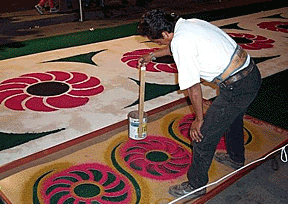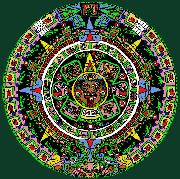The festivities–and there are many–begin the first weekend in
August and end 17days later. In between lies the Feast of the Assumption
of the Virgin Mary and it’s for that feast day that the townspeople
create the street carpets.
 The
floral carpets of Huamantla originated from the pre-Hispanic celebration
in honor of Xochiquetzalli, the goddess of Fertility. Centuries later,
the people of Huamantla continue this tradition decorating their
churches and streets with flowers, in order to honor their patron saint,
the Virgin of Charity. Workers by day, it’s necessary to wait until
the business day ends before work on the carpets can begin. While the
artists decorate some of the streets with fresh cut flowers and moss–usually
those closest to the church and in the direct path of the procession–they
decorate most of them with colored sawdust which they sieve through
stencils to create fantastic floral and geometric designs and borders.
The
floral carpets of Huamantla originated from the pre-Hispanic celebration
in honor of Xochiquetzalli, the goddess of Fertility. Centuries later,
the people of Huamantla continue this tradition decorating their
churches and streets with flowers, in order to honor their patron saint,
the Virgin of Charity. Workers by day, it’s necessary to wait until
the business day ends before work on the carpets can begin. While the
artists decorate some of the streets with fresh cut flowers and moss–usually
those closest to the church and in the direct path of the procession–they
decorate most of them with colored sawdust which they sieve through
stencils to create fantastic floral and geometric designs and borders.
The focal point of the celebration is the main church in town, which
the more artistic workers decorate with intricate paintings by gently
pouring colored sand into a design drawn on the surface. Most often,
these contain figures or tell a story.
But the highlight of this religious weekend is the solemn religious
procession, which begins between 11 P.M. Saturday and 1:30 A.M. Sunday.
A young woman, chosen to represent the Virgin Mary, leads the procession
over the newly-created carpets to the church. The procession thus
consecrates the work. The best viewing time is late afternoon and
evening when townspeople, pilgrims, and tourists view the carpets.
As the Virgin passes by, followed by the faithful who accompany her,
the sound and color of fireworks fills the sky. The flowers, booms of
the rockets, dazzling lights, singing and prayers full of hope and
faith, create a truly memorable scene. When the Virgin finally enters
the church at around 7 A.M., the faithful celebrate a solemn mass to
confirm their faith and love for her.
With the religious celebration as its focus, the Humantla Fair offers
traditional attractions and rides, plus cockfights, concerts, art and
cattle exhibitions and a large market featuring local products, as well
as food stands serving delicious Tlaxcalan dishes and snacks. There’s
a donkey race, a charreada or rodeo, and a race of souped-up old cars–although
I’m not sure what any of these has to do with the Virgin Mary.
One of the special events is the 30-year-old Huamantlada, the
Tlaxcaltecan version of the running of the bulls in Pamplona, Spain,
held on the Saturday following the procession. Here, as there, young men
challenge death in order to feel the danger and to prove their ability
as bullfighters.
Approximately 10 to 25 fighting bulls and hundreds of young men from
Tlaxcala, as well as from all over the country who have longed to be
bullfighters, meet in the streets of Huamantla. A few minutes before
Noon, after setting off two huge rockets, they free the bulls, Young men
carrying bullfighter's capes anxiously await the great moment. Then they
fire a third huge rocket and shouting indicates that the bulls have been
let loose. Crowds of young men provoke them running in front of them and
dodging them. Many wannabe matadors confront the poor animals. Some of
the young men are lucky enough to maneuver out of the path of the bulls,
but others aren’t so lucky, as the bulls charge them. By 2 P.M., the
hot Tlaxcalan sun overtakes the bulls, and they soon go away tired and
stunned by the number of "bullfighters" during the running.
The Huamantla Fair is becoming increasingly popular. While the second
Saturday is the most popular day, the fair runs two weeks. Last year
more than 350,000 people took part in the festivities.

